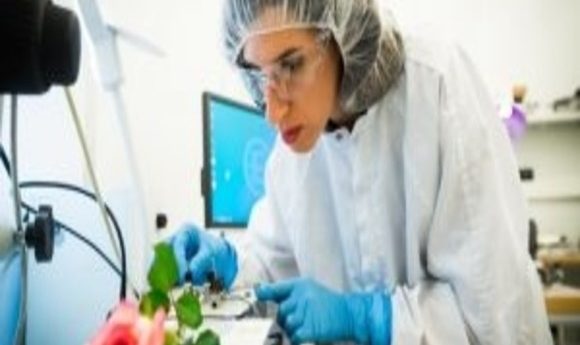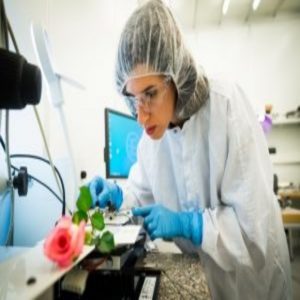Flower power: roses transformed into supercapacitors

Roses no longer only symbolize romance; they now represent the power of plants as alternative energy systems.

Eleni Stavrinidou working on the supercapacitor rose.
Credit: Thor Balkhed, Linköping University
Picture the classic first date: A guy brings a girl vibrant flowers—a lovely gesture to set the mood. But today, most of us want something a bit more practical, perhaps a spare charger to prevent our smartphones from dying by date’s end. If only there were a sensible yet romantic first-date gift.
Well, in the future, it may be possible to charge a cell phone using a bouquet of roses. At Linköping University’s Laboratory of Organic Electronics (LOE) in Sweden, a group of bioengineers recently developed a prototype rose supercapacitor. This electronic plant, (e-Plant) can store energy and repeatedly charge devices with no loss in power. The researchers published their results in the journal Proceedings of the National Academy of Sciences.
“Plants are dispensable parts of our lives and our ecosystem,” said Eleni Stavrinidou, a postdoctoral fellow at LOE and the lead author of the study. “Roses are everywhere and, in particular, have a great structure to interface with electronics.”
In order to turn a single rose into a supercapacitor, the engineers injected a conductive polymer solution into the rose’s vascular system that would wire throughout the entire plant. Part of this polymerization effect was catalyzed by the rose’s own defense mechanism—an oxidation reaction—that viewed the polymer as a “weak pathogen” and localized it to the xylem, or veins, of the plant. This was an ideal situation since the polymer wouldn’t be able to damage the plant’s organs or cell walls.
Once the circuitry was in place, the researchers placed two gold electrodes at the end of the stem, where two parallel xylem wires were located, to “charge” the rose using its own flow of electrons. By demonstrating excellent storage capacity and delivery performance, Stavrinidou’s team showed that e-Plants could be capable of a wide variety of applications.
Going beyond proof-of-concept, Stavrinidou and her team at LOE want to tackle energy harvesting from the rose storage system and even transfer this technology to plants that are in the soil. The present system was a severed rose already on its way to death, so the team wants to compare a live, rooted system with the plucked, dying plant. From the rose, the team also plans to branch out and test other plants and potentially build fuel cells in a variety of flora.
“The rose is symbolic of many things,” Stavrinidou said. “Now its purpose as a ‘power plant’ will hopefully help us extend our technology further into other abundant plant systems, such as trees, which could be a great alternative energy source.”
Soon, visiting the botanic garden or walking through dense forests may be a more electrifying first date.